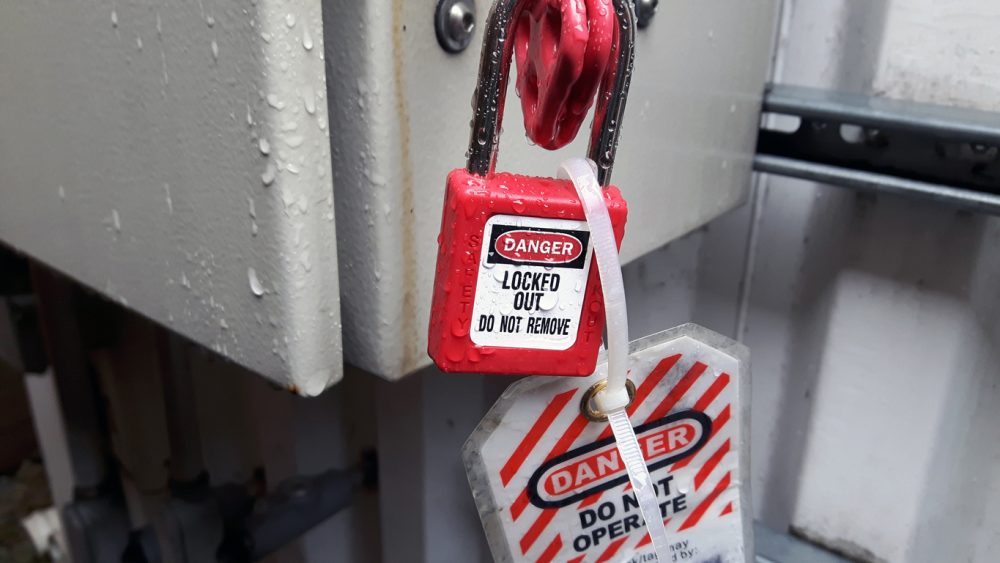Employers need to understand how important lockout and tagout procedures are to ensure safety on the job and that these procedures are only effective when employees follow through on all the steps in the full lockout/tagout process.
Author: Reviewed by Amerisafe Safety Consultants
What is a Lockout/Tagout?
A lockout tagout procedure is used to ensure potentially dangerous equipment is properly shut off and can’t be started until work is complete. The lockout procedure occurs when an energy-isolating device prevents the release of energy in a piece of equipment. So, for example, when a padlock closes up a circuit breaker, this is an example of a “lockout.” This process is used to control hazardous energy sources and improve occupational safety.
A tagout is when an employee fixes a tag with their contact information to a piece of equipment, stating that it has been locked out. Both steps of the lockout/tagout process are essential for controlling hazardous energy and dangerous equipment using the proper safety devices. In turn, employees can feel safer during the next shift.
Workers must follow every step of a lockout/tagout process. However, steps may be skipped if they don’t understand the importance of what they’re doing. It can be difficult to break down and translate the significance of each step in a complex process such as lockout/tagout procedures.
So what can employers do when they find their employees skipping critical steps in the lockout/tagout process? They can emphasize the seven key steps in lockout/tagout procedures and communicate why they are essential to protect everyone and reduce the potential for serious injury.
NOTE: ONLY AUTHORIZED PERSONS SHOULD PERFORM LOCKOUT/TAGOUT PROCEDURES
7 Key Steps in Lockout/Tagout Procedures
Here are seven key steps to follow during lockout/tagout procedures:
- Identify the Procedure to Use – Identify which lockout/tagout procedure is appropriate for your equipment. Make sure you have the proper energy control devices and other lockout devices.
- Prepare for the Equipment Shutdown – Next, prepare for the shutdown by identifying which equipment needs to shut off, what switches to pull, and what order to follow
- Notify All Affected Employees – Communicate to all affected, authorized personnel that your lockout/tagout procedure is about to begin.
- Equipment Shutdown – Next, shut down the equipment safely and carefully.
- Add the Individual Locks – Secure individual locks for all equipment that needs it, and add appropriate tags. Locking out all power sources ensures worker safety.
- Check Stored Energy – Ensure all machines are disabled to prevent the release of stored, residual energy that can injure employees.
- Verify Isolation – Before starting work again with machines that have been locked out or tagged out, verify each piece of equipment’s energy isolation and de-energization.
What: Are Procedures Detailed and Accessible?
Lockout/tagout as a process requires precise steps to be followed to ensure the maintenance and service work can be completed safely. This is why it’s so important that all authorized employees easily understand the lockout/tagout procedures.
The lockout/tagout procedures should be thoroughly detailed so every authorized employee can follow the steps consistently. Any vague instructions or gaps between steps open up opportunities where vital checks and tests can be skipped—intentionally or mistakenly.
Taking the time for detailed, proper training standardizes the work and makes it easier to understand. This guarantees minimal knowledge gaps and makes it easier to verify the work is done correctly every time.
How: How Current Are Your Lockout/Tagout Procedures?
Companies should regularly review their lockout/tagout procedures to make sure the information is still relevant and current for their needs. This also includes auditing lockout/tagout work and energy control programs to determine that the work is completed correctly. Up-to-date information is required if employers expect their employees’ work to be as safe as possible.
Workers who operate without the most recent or relevant information are also more prone to make policy errors. This includes using other employees’ locks, not swapping correctly during shift changes, or not notifying affected employees correctly. And each of these issues is just as hazardous as a procedural error.
This is also why regular training and education are essential. Refreshing employee knowledge on lockout/tagout policies and processes helps keep everyone on the same page and puts the knowledge of procedures front and center.
Why: Are Procedures Reinforced by Your Safety Culture?
A company’s culture of safety will define how seriously any worker treats safe-working procedures. This is why adhering to strict, standardized lockout/tagout procedures is so important. Employees that notice their superiors shirking off their audits or turning a blind eye to procedure mistakes will also take their work less seriously. And this leads directly to skipped process steps and increased risks that should be otherwise avoidable.
One prominent way to reinforce a company’s commitment to safety and show buy-in from management is by providing hands-on education with safety experts. Partnering with the safety experts at Amerisafe Group provides companies with comprehensive safety education that builds the foundation for a strong workplace safety culture.
Importance of Lockout/Tagout Procedures
Amerisafe Group understands the importance of lockout/tagout procedures, which is why we have training that details these processes. By utilizing our experience and skill in workplace safety, your company can align with workers’ perceptions of safety and boost their engagement in safe practices. This creates a workforce of aligned employees committed to following proper lockout/tagout procedures. Not only are they ready to follow each step, but they understand why lockout/tagout is so critical. As a result, your whole team will be safer.
In addition to our safety training and consulting services, Amerisafe also provides occupational health medical services, rescue services, and more. If you are looking for qualified safety consultants and healthcare professionals for your job site, contact our team today.









